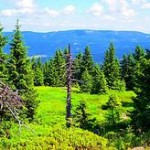GRANTS PASS, Ore.–The U.S. Bureau of Land Management is rolling out the first new timber sale under the Western Oregon Plan Revision, known as The Whopper.
In documents posted on the Internet Jan. 27, the BLM’s Coos Bay District is proposing 1,400 acres of clear-cuts and 200 acres of thinning on more than 50 scattered parcels in the Coast Range near the small towns of Langlois and Sixes.
Though the thinning projects would cut trees in buffer zones along streams intended to protect salmon under the 1994 Northwest Forest Plan that Whopper replaces, the clear-cuts stay out of former reserves for northern spotted owls and other old growth forest species.
The Edson Regen project would not be ready for logging until 2010, by which time BLM hopes the housing bust and dismal timber market will have improved, spokeswoman Megan Harper said Wednesday.
Last month a thinning project in the same area failed for the second time to get any takers. Minimum bids called for a total of $217,596 for 6 million board feet of various species, BLM records show.
Edson Regen would produce 40 million board feet of timber, nearly half the 100 million board feet BLM sold last year. In all, Whopper calls for 510 million board feet a year.
Whopper was the Bush administration’s last big effort to boost logging in the Northwest to increase timber supplies for mills and federal payments for timber-dependent counties, which get a 50-percent share of revenues from what are known as O&C Lands managed by BLM.
The Whopper has been sharply criticized by conservation groups for jettisoning the Northwest Forest Plan, which cut logging by about 90 percent on federal lands in Washington, Oregon and Northern California in 1994 to protect habitat for the northern spotted owl, salmon and other species that depend on old growth forests.
Whopper faces legal challenges from both the timber industry and conservation groups for its failure to consult federal scientists over the potential harm to salmon, spotted owls and marbled murrelets.
“This plan that was come up with under the Bush administration is really out of step with where everyone else is moving in terms of forest management,” said Sean Stevens of Oregon Wild, noting that Sen. Ron Wyden, D-Ore., has proposed a bill to put trees more than 120 years old off-limits to logging on federal lands.
Earthjustice, a public interest environmental law firm, has written Interior Secretary Ken Salazar urging him to reconsider The Whopper because BLM decided not to consult federal biologists over endangered species impacts, going against federal appeals court rulings on the issue.
Tom Partin of the American Forest Resource Council, the timber industry group whose lawsuit prompted The Whopper, said they will be lobbying Congress to boost funding for BLM by 30 percent or more to pay for the extra work it will take to reach Whopper’s increased logging goals.
BLM spokeswoman Megan Harper said they are in the preliminary planning stages of the project, and have sent some initial information to the U.S. Fish and Wildlife Service and NOAA Fisheries Service. Full consultation after details of the logging are set is expected in about a year.
The Edson Regen project is proposed in second-growth stands ranging in age from 50 to 159 years old, Harper said. That avoids conflict with The Whopper’s prohibition on logging in stands older than 160 years for the next 15 years.
The clearcuts are slated for areas that were designated for timber production by the Northwest Forest Plan. The thinning projects are slated for areas along rivers that formerly were off-limits to most logging. Whopper cut riparian reserves from two tree lengths, under the Northwest Forest Plan, to one tree length.
Disclaimer: Articles featured on Oregon Report are the creation, responsibility and opinion of the authoring individual or organization which is featured at the top of every article.


